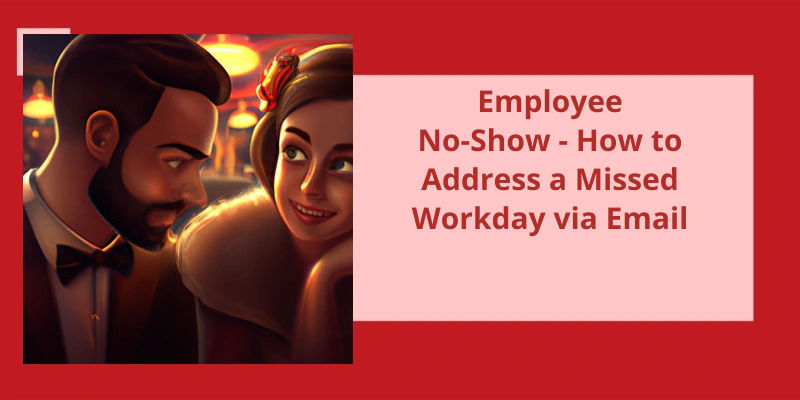It's an unfortunate reality that employees sometimes are unable to show up for work. There are any number of reasons why someone might have to miss a day at their job, whether it's due to illness, family obligations, or other unexpected circumstances that come up. Regardless of the reason, it's always frustrating when an employee doesn't show up for work – and when that happens, it's important for bosses and managers to take the appropriate steps to address the situation. One common way to handle these situations is to send an email to the employee in question, discussing their absence and any steps they'll need to take to make up for the missed work. But how should you approach this correspondence, and what’re the best practices for communicating with an absent employee? Here are a few things to keep in mind if you're dealing with an employee who didn't show up for work.
What Do You Say to an Employee Who Doesn’t Show Up for Work?
One of the most challenging situations a manager or employer may face is when an employee doesn’t show up for work without prior notice. This not only disrupts the workflow but can also lead to significant financial losses. So, what do you say to an employee who doesn’t show up for work?
The first step is to try to reach out to the employee. If you get them on the phone, calmly explain that they missed a scheduled shift and ask if everythings okay. Avoid being accusatory and focus on showing concern. It’s possible that something serious could be behind the reason they failed to come in for work. Listening to them can help you come up with a plan to address the situation.
If you cant reach the employee directly, leave a message asking them to call you back as soon as possible. It’s essential to approach the situation calmly, while being firm enough to indicate that this situation won’t be tolerated without a valid explanation. The employee has a responsibility to be honest and forthcoming regarding the reasons behind their missed shift.
It’s essential to remember that each situation is unique, and there may be many different reasons why an employee doesn’t show up for work. However, finding out those reasons is key to managing the situation effectively. An employee who misses work due to a personal emergency may need an understanding, supportive approach. On the other hand, an employee who misses work without considering the impact it’s on their colleagues and business may require more significant disciplinary action.
If an employee has a pattern of no-shows or lateness, it may be necessary to implement a stricter policy. Keeping detailed records of an employees attendance can help identify patterns, and this will allow for more informed decisions to be made. Communication is important, emphasizing the importance of their attendance to their colleagues and the business.
It’s crucial to stay calm, communicate your expectations clearly, and listen carefully to their reasons for missing work. Whether it’s a simple explanation or a more personal issue, every case should be treated with compassion and respect. By engaging in open communication, you can better understand the reasons behind the no-show and work together to support your staff moving forward.
What Are the Legal Considerations When an Employee Doesn’t Show Up for Work?
When an employee doesn’t show up for work, there are several legal considerations that employers need to keep in mind. These include factors such as the employment contract, company policies, and applicable employment laws. It’s important for employers to handle the situation in a fair and consistent manner, while also ensuring compliance with legal requirements.
It’s a situation no employer wants to face, but sometimes an employee may go missing or go AWOL (absent without leave). Knowing how to handle this situation is important for any business. While it’s important to consider the circumstances and try to reach out to the employee, it’s also crucial not to assume they’ve resigned. And if they return to work, it may be necessary to investigate and potentially take disciplinary action.
What to Do if an Employee Goes Missing?
When an employee goes missing, the first course of action is to consider the circumstances surrounding it. It could very well be that the employee has a legitimate reason for not showing up to work, such as a family emergency or personal health issue. In this case, it would be best to exercise compassion and understanding, and to work with the employee to find a solution that’s accommodating to both parties.
However, it’s also possible that the employee has gone AWOL intentionally, without giving any notice or explanation. In this case, it’s important to do everything possible to get in touch, whether that means calling, emailing, or even visiting their home. It’s often helpful to reach out to the employees emergency contact, as they may have information that could shed light on the situation.
One mistake that many employers make is assuming that the employee has resigned simply because they haven’t shown up for work. It’s important to give the employee the opportunity to explain themselves before jumping to any conclusions. This can be done by sending a formal letter or email asking the employee to contact you as soon as possible to discuss their absence.
If the employee does eventually return to work, it’s important to investigate the reasons behind their absence. Depending on the circumstances, it may be necessary to take disciplinary action, such as issuing a verbal or written warning, or even termination of employment.
Ultimately, it’s important for employers to have a clear protocol in place for dealing with employee absences. This should include steps to take if an employee goes missing, as well as procedures for documenting and investigating the absence once the employee returns. By being prepared and taking a professional approach, employers can ensure that they’re able to handle any situation that arises with their employees in a fair and effective manner.
How to Create an Employee Absence Policy
An employee absence policy is an important aspect of managing a company’s workforce. It outlines the procedures for requesting time off, the types of absences that are allowed, how much notice an employee should give before taking leave, and the consequences of failing to follow the policy. To create an effective employee absence policy, employers should consider the needs of the company and the legal requirements for providing leave to employees. It should be clearly communicated to all employees and consistently enforced.
Conclusion
In conclusion, the issue of employees not showing up for work emails is a complex one that requires careful consideration and strategic action. It’s important for employers to establish clear and consistent communication channels with their employees and to provide adequate training and support to ensure that they understand their responsibilities and are able to perform their duties effectively. Additionally, workplace culture and morale play a key role in employee motivation and commitment, and employers must make a concerted effort to create a positive and empowering work environment that encourages employees to participate and contribute to the success of the organization. Ultimately, addressing the problem of employees not showing up for work emails requires a collaborative and holistic approach that involves communication, training, support, and cultural change. With the right strategies in place, it’s possible to cultivate a workforce that’s engaged, productive, and committed to achieving common goals.






